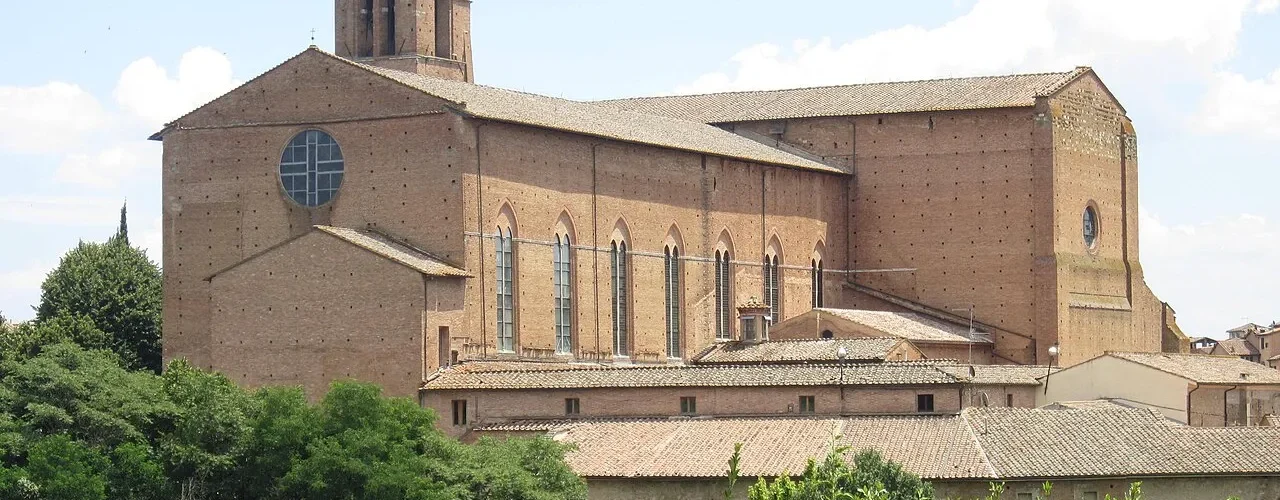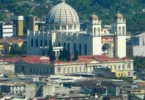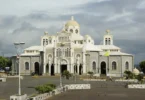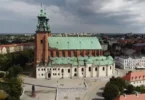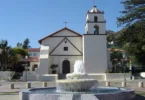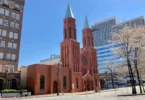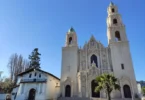Introduction
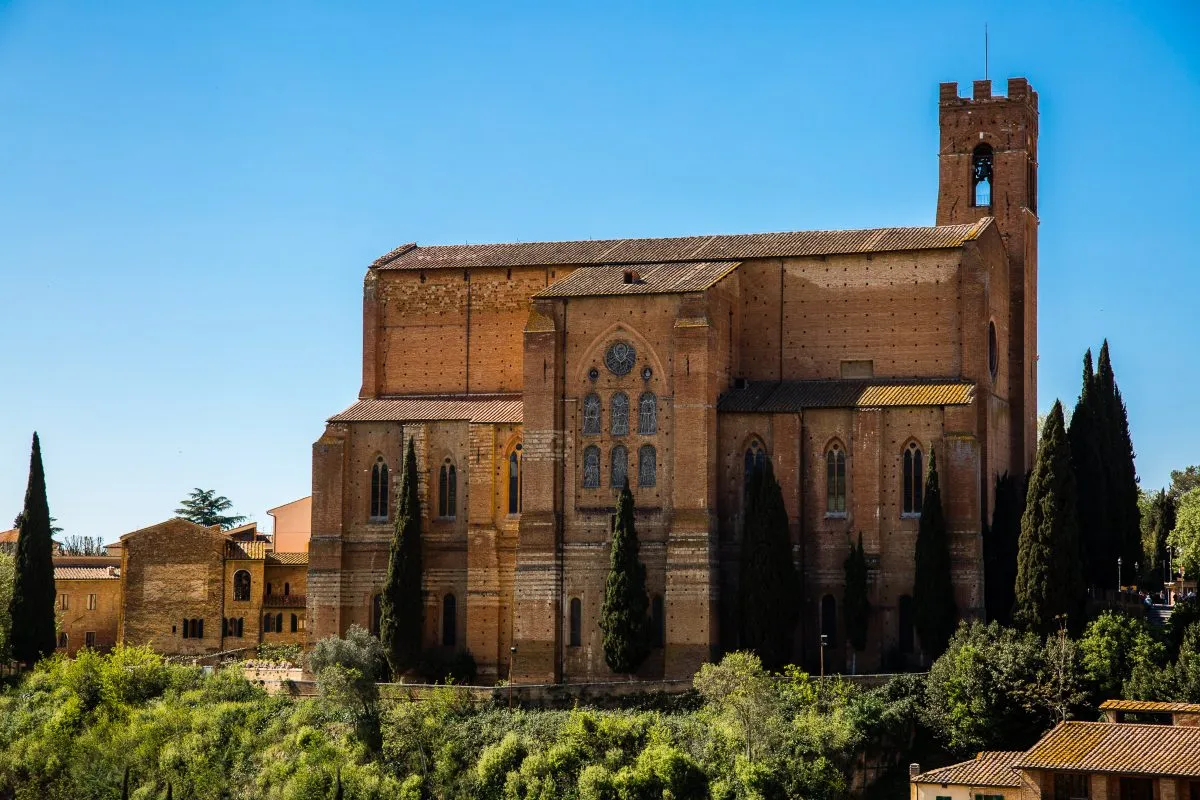
The Basilica of San Domenico, located between Piazzale di San Domenico and Via della Sapienza in Siena, is one of the city’s most significant churches. Originally built in the 13th century, it was expanded in the following century. The basilica houses the head relic of Saint Catherine of Siena, placed in a stunning Renaissance chapel constructed specifically for it, with frescoes by Sodoma and others. Often referred to as the Basilica of Saint Catherine due to its association with the Sienese saint and key events from her life, the church is also recognized as an Italian national monument.
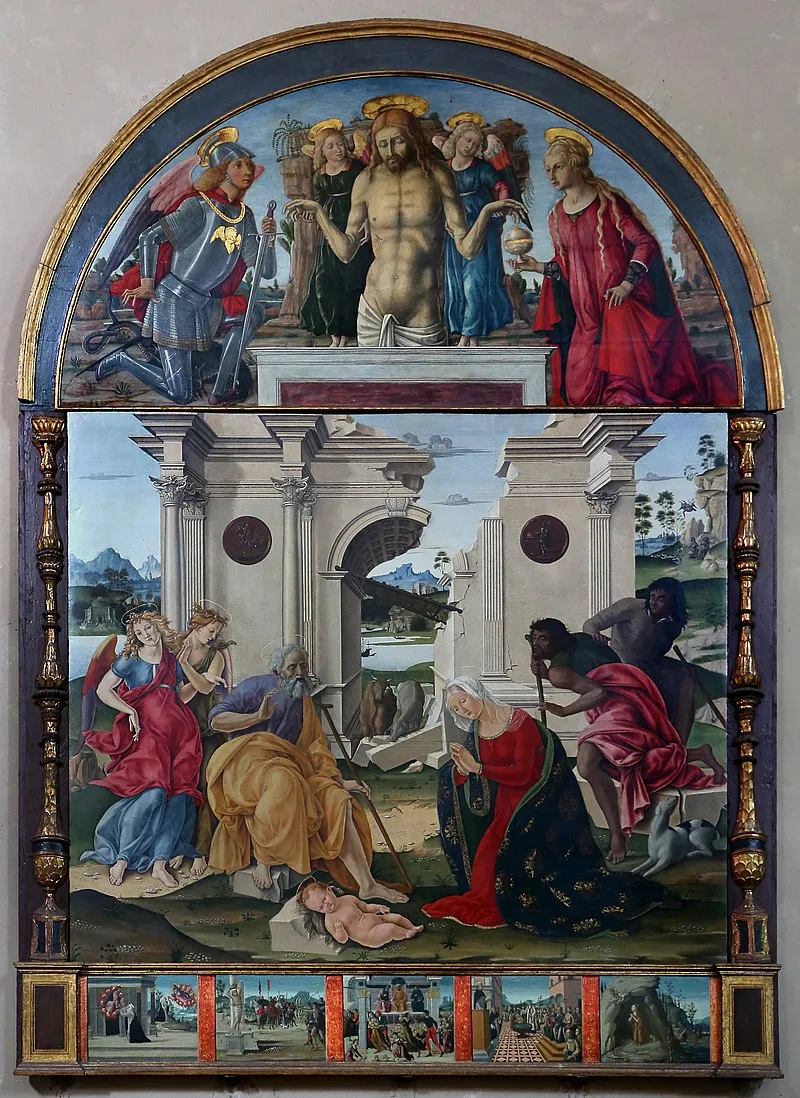
The Dominican Order arrived in Siena in 1220, just a year before the death of its founder, Saint Dominic (Domenico di Guzmán). In 1225, the order received a generous land donation from Fortebraccio Malavolti, a prominent Sienese nobleman. This gift laid the foundation for the construction of a grand Dominican church in the city.
Construction of the church began in 1226 and continued until 1265. However, during the 14th century, the complex underwent significant expansion, adopting the imposing Gothic architectural style that largely defines its appearance today. The building process was carried out in multiple phases, with various additions and modifications over the centuries. The church was finally completed in 1465.
Throughout its long history, the structure has endured several calamities, including devastating fires in 1443, 1456, and 1531. Following the last of these fires, the church was restored by the architect Domenico Cinquini. In addition to fire damage, the church also suffered military occupations between 1548 and 1552, as well as severe structural damage caused by earthquakes, most notably in 1798.
During the 17th and 18th centuries, the church underwent significant Baroque-style renovations. These alterations included the addition of elaborate decorations and the reconstruction of the side altars, which changed the medieval character of the building.
The 1798 earthquake left the bell tower in an unstable condition, prompting significant structural modifications. As a result, the tower was shortened to its current height and given a distinctive crenellated crown. For similar stability concerns, the central rose window of the façade, along with the large side windows, was sealed off.
A major restoration project took place between 1941 and 1963, aiming to undo many of the Baroque modifications and restore some of the original Gothic elements. During this period, modern stained glass windows depicting scenes from the life of Saint Catherine of Siena were installed, created by the artist Bruno Cassinari.
In recognition of its historical and religious significance, Pope Pius XI elevated the church to the status of a minor basilica in July 1925. Today, the Basilica of San Domenico remains one of Siena’s most important religious and architectural landmarks, deeply connected to the city’s history and spiritual heritage.
Architecture of Basilica of San Domenico, Siena, Italy
Architectural Styles: Gothic architecture, Italian Gothic architecture
Perched atop the tuff hill of Camporegio, the Basilica of San Domenico dominates the landscape overlooking the Fontebranda plain. From its elevated position, visitors can enjoy breathtaking panoramic views of Siena’s iconic landmarks, including the Cathedral and the Torre del Mangia.
Exterior Architecture
The basilica presents a stark and imposing appearance, characterized by its austere brick construction. This architectural simplicity reflects the principles of the mendicant orders, which favored modest and unembellished materials for their churches. The structure is predominantly Gothic in style, with strong influences from Cistercian Gothic architecture, particularly evident in the apse.
The basilica’s main entrance is located on its left side, which is the most visible part when viewed from the adjacent square. This entrance is marked as number 21 on the basilica’s map. The right side, in contrast, is largely obscured by the adjoining convent buildings.
The façade is a simple, gabled structure with minimal ornamentation. Its only notable feature is a large, high-set circular window, or oculus, which serves as a substitute for a traditional rose window. A distinctive aspect of the façade is the presence of the Cappella della Volta (Vault Chapel), which extends outward from the church’s interior and partially obscures the façade. This unusual feature meant that the church’s main entrance had to be placed on the left side rather than at the front, as there was no available space for a traditional doorway.
The rear of the basilica, featuring the transept and terminal chapels, offers a particularly striking view. This perspective is best appreciated from vantage points on the opposite hillside, such as Via di Fontebranda or Via di Diacceto.
To the left of the basilica stands its bell tower, originally constructed in 1340. However, in the early 18th century, the tower was reduced in height for structural reasons. Following the earthquake of 1798, it was further modified and given its current crenellated crown, which adds a distinctive medieval character to the structure.
Interior of the Basilica
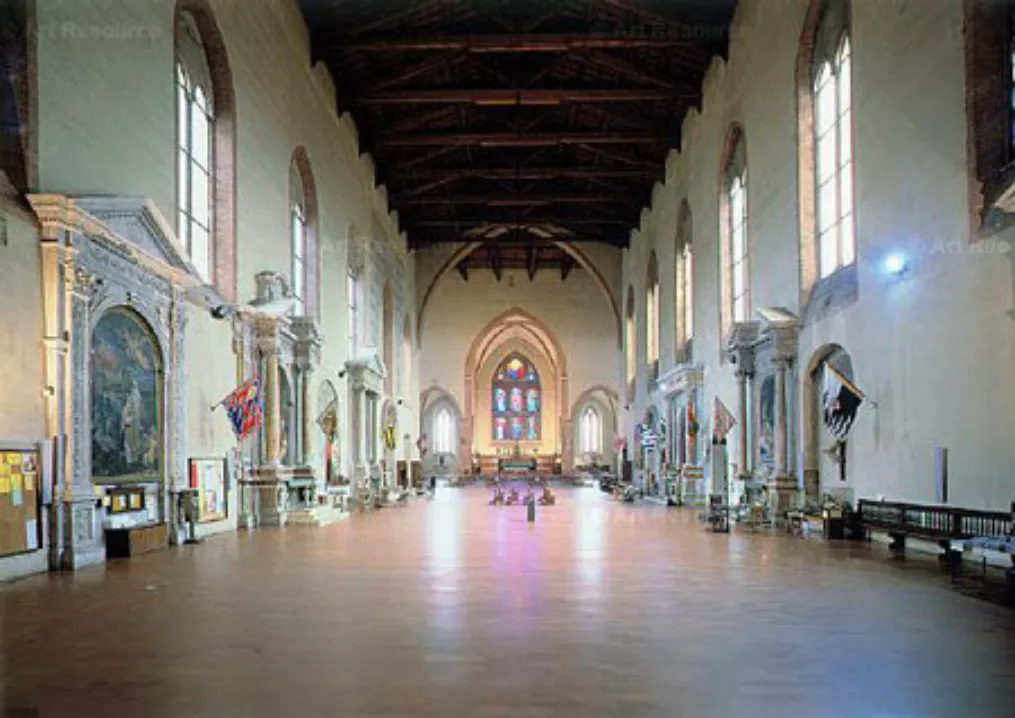
Architectural Layout and Design
The basilica follows an Egyptian cross floor plan, featuring a single vast nave covered by exposed wooden trusses. The transept extends into several chapels along the rear wall, each capped with cross vaults and terminating in a flat wall. The central chapel, while architecturally similar to the others, stands out due to its greater height, width, and depth.
The architectural design, influenced by Cistercian principles, reflects the ideals of mendicant orders, who sought to create large, open spaces suitable for preaching to vast congregations while avoiding excessive ornamentation. The nave’s vertical structure is divided into two levels: the first houses a series of altars, while the second features tall Gothic windows adorned with stained glass. These windows were designed by renowned 20th-century artists, including Bruno Saetti, Domenico Cantatore, Fabrizio Clerici, Giorgio Quaroni, and Bruno Cassinari in the presbytery.
Though the walls were plastered during the 20th-century restorations, they remain richly decorated with significant paintings. Among the most treasured spaces within the basilica is the Chapel of Saint Catherine, located along the right wall of the nave. This chapel enshrines the head relic of Saint Catherine and is regarded as a masterpiece of Renaissance art.
The Chapel of the Volte
Located at the back of the church, the Chapel of the Volte is accessed through two large arches supported by pillars and stands elevated above the basilica’s main floor. Originally constructed in the 14th century, it served as the prayer space for the Mantellate, the Dominican Tertiaries.
Historically, this chapel was separated from the nave by a wall, and access was limited to a small staircase—remnants of which are still visible. However, the 20th-century restorations removed this dividing wall and introduced a grand staircase on the right to facilitate entry.
This sacred space holds immense spiritual significance, as it was here that Saint Catherine of Siena received her Mantellate habit. She is said to have experienced divine ecstasies, recited Psalms alongside Christ, exchanged her heart with Him, and symbolically offered Him her pilgrim’s robe.
The chapel houses several invaluable artworks. A 14th-century fresco by Andrea Vanni, located on the back wall, is particularly significant as it is considered an authentic portrait of Saint Catherine—painted by a disciple who had personally known her. Other notable works include:
Canonization of Saint Catherine by Mattia Preti (1672–1673). Two paintings by Crescenzio Gambarelli (1602), depicting Saint Catherine offering her habit to Christ and Christ returning a small cross to Catherine.Apparition of Saint Catherine to Saint Rose of Lima by Deifebo Burbarini (17th century). Death of Saint Catherine and Saint Catherine Reciting the Office with Christ, both by Crescenzio Gambarelli (1602). The chapel is further adorned with Renaissance-era wooden choir stalls, adding to its historical and artistic significance.
Nave
Left Wall of the Nave
The altars along the left wall contain several remarkable paintings. The first altar houses Saint Hyacinth of Poland Saving the Statue of the Virgin and the Blessed Sacrament from a Fire, painted by Francesco Vanni in 1600. The second altar features the Mystical Marriage of Saint Catherine of Alexandria by Alessandro Casolani, while the third altar holds Saint Anthony the Abbot Freeing a Possessed Woman, painted by Rutilio Manetti in 1628. Additionally, the predella, which showcases fifteen small panels depicting the Mysteries of the Rosary, has been recently attributed to Sodoma and dates back to the early 16th century.
Right Wall of the Nave
The right wall features an impressive collection of religious artworks. Among them is The Apparition of the Virgin to the Blessed Gallerani, painted by Stefano Volpi in 1630. Another notable piece is The Nativity of the Virgin, created by Alessandro Casolani between 1584 and 1585. This painting, originally commissioned for the Chapel of the Volte, is considered Casolani’s masterpiece. It exemplifies the transition from Beccafumi-inspired Mannerism to a more emotional and devout Baroque style.
Further along the wall, a shrine containing relics of Saint Catherine is prominently displayed. Beyond this, there is a 16th-century canvas by Sodoma, depicting the Martyrdom of Saint Sebastian, Saint Catherine, Saint Sigismund, Saint Vincent Ferrer, and God the Father.
Another remarkable work is the Adoration of the Child, painted by Francesco di Giorgio around 1490. This painting is complemented by a lunette by Matteo di Giovanni, depicting the Pietà between Saints Michael and Mary Magdalene, and a predella attributed to Bernardino Fungai, featuring five narrative scenes of various origins.
Chapel of Saint Catherine
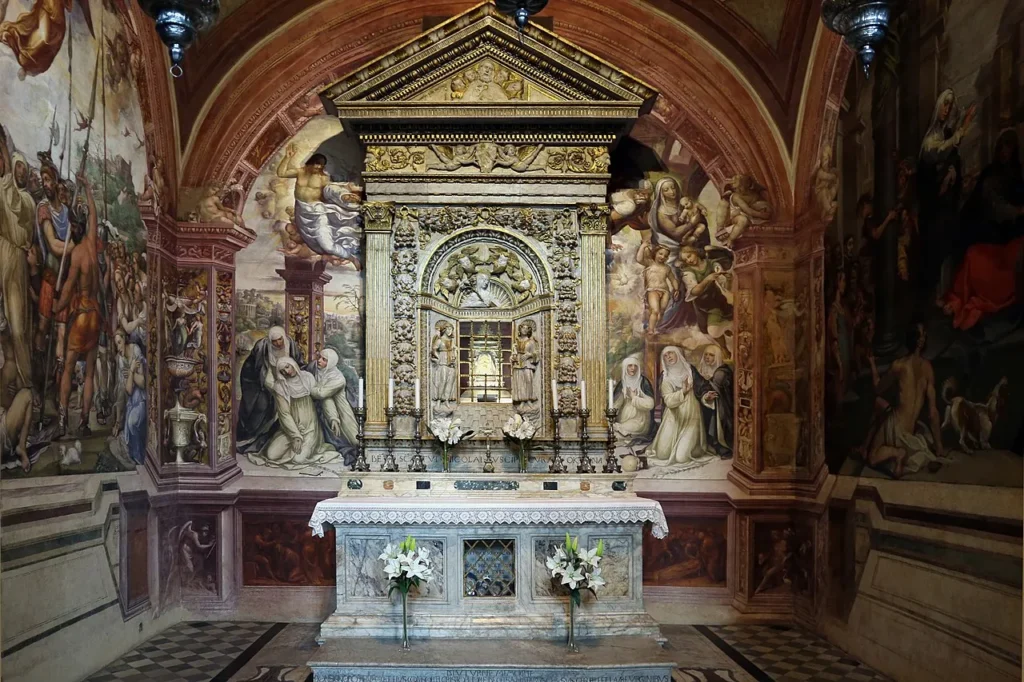
The Chapel of Saint Catherine, located along the right nave, was commissioned in 1466 by Niccolò Bensi to enshrine the revered relic of Saint Catherine’s head. This sacred relic was separated from her body by her confessor, Blessed Raimondo da Capua, the day after her death in 1380 in Rome. Due to the persistent appeals of the people of Siena, who sought to have a relic of their beloved saint, the head was brought to Siena in 1384, becoming a cherished spiritual treasure.
At the center of the chapel is a marble altar, sculpted by Giovanni di Stefano in 1469 upon the request of Bensi. The relic itself is placed behind an ornate grill, inside a neo-Gothic reliquary designed in the 20th century in the shape of a miniature temple. The chapel’s walls are adorned with 16th-century frescoes by Sodoma and Francesco Vanni, which depict significant moments from Saint Catherine’s life. On the left wall, Sodoma’s painting of the Beheading of Niccolò di Tuldo (1526) captures the execution of a young man whom Catherine consoled and converted before his death. The back wall features two of Sodoma’s finest works from 1526: The Ecstasy of Saint Catherine (left) and The Fainting of Saint Catherine upon Receiving the Stigmata (right). On the right wall, Francesco Vanni’s painting, Liberation of a Possessed Woman by Saint Catherine (1596), is executed in oil on plaster. Vanni also painted the figures of Raimondo da Capua and Antonio Nacci (“Caffarini”) on the chapel’s arch—two scholars who authored major biographies of the saint. Above, in the archway, Sodoma painted depictions of Saints Luke and Jerome.
The chapel’s floor is a remarkable marble inlay attributed to Francesco di Giorgio, dating back to the 15th century. Interestingly, it features a scene from Greek mythology, Orpheus and the Animals, a rare artistic subject in a religious setting. The pillars of the chapel are decorated with intricate 16th-century grotesques, further enhancing its artistic beauty. After the 1798 earthquake, the chapel’s dome was reconstructed to restore its structural integrity.
To the right of the chapel, a small panel displays an image of Blessed Caterina dei Lenzi, a 15th-century figure who is sometimes mistaken for Saint Catherine of Siena. The current artwork is a modern reproduction of an earlier painting that was widely venerated in Siena until its destruction in 1939.
The Chapel of Saint Catherine remains one of the most spiritually and artistically significant spaces within the basilica, serving as a lasting tribute to one of Siena’s most venerated saints.
Transept
Right Transept
The right transept is accessed through a towering pointed arch that separates the nave from the crossing. At the far end, the Baroque altar is dedicated to Blessed Ambrogio Sansedoni (11), with a central painting by Francesco Rustici, Blessed Ambrogio Sansedoni Appearing to Blessed Nera Tolomei (1611–1612). Flanking the altar are two marble statues—Saint Thomas Aquinas on the left and Blessed Jacopo da Mevania on the right.
Moving towards the center, the first chapel houses a remarkable double fresco from the early 16th century, discovered beneath the floor in a tomb. The fresco depicts the Madonna Enthroned with a Patron and Two Saints.
The second chapel (12) contains a marble altar with a crucifix at its center, flanked by statues of Saint Barbara and Saint Mary Magdalene, attributed to the school of Giambologna (1595). This chapel is notable for its series of sepulchral monuments along both side walls, particularly those dedicated to German students and scholars who attended the University of Siena during the 16th and 17th centuries.
The third chapel (13) features a significant painting on the right wall, Madonna and Child Between Saints Jerome and John the Baptist by Matteo di Giovanni (1476). The chapel also preserves fragmentary 14th-century frescoes that were originally part of the convent cloister.
Main Chapel
At the heart of the central chapel (14), a modern altar is enhanced by a ciborium and two angelic sculptures by Benedetto da Maiano (circa 1475). The backdrop features the Martyrdom of St. Peter of Verona, a painting by Arcangelo Salimbeni (1579), alongside other minor works from the 17th and 18th centuries. From a portal at the back of the chapel, visitors can enjoy an impressive panoramic view of Siena’s historic center.
Left Transept
In the left transept, the first chapel (15) houses the painting Crucifixion with Saints Eugene and Benedict by Raffaello Vanni (1649) and a finely crafted wooden statue of Saint Anthony the Abbot, carved by Francesco di Valdambrino, a student of Jacopo della Quercia, and later polychromed by Martino di Bartolomeo (1426). A significant detached fresco, Madonna and Child with Saint John the Baptist and a Kneeling Knight, by Pietro Lorenzetti (circa 1325), originally from the convent cloister, is displayed on the left wall.
The second chapel (16) is the most ornate and monumental within the transept, featuring elaborate stucco work and frescoes by Giuseppe Nasini. Its centerpiece is the grand Maestà by Guido da Siena, a panel painting signed by the artist, with an inscription that reads:
“Me Guido de Senis diebus depinxit amenis quem Christus lenis nullis velit angere penis – Anno Domini MCCXXI”.
While this date (1221) would make the painting one of the earliest and most purely Byzantine works in Tuscan and Italian art, scholars now widely believe it was created around 1270, possibly influenced by Coppo di Marcovaldo’s arrival in Siena in 1261. It is also suggested that a later Duccio-style artist repainted the faces of the Virgin and Child.
The side walls of the chapel feature two exceptional paintings. On the left wall, Madonna and Child Between Saints Gregory, James, Jerome, and Sebastian, with a lunette above depicting the Pietà, was painted by Benvenuto di Giovanni in 1483. On the right wall, Saint Barbara with Saints Mary Magdalene and Catherine of Alexandria, with a cymatium depicting the Epiphany, is a masterpiece by Matteo di Giovanni from 1479.
The seventh chapel features a wooden crucifix, attributed to Vecchietta (late 15th century).
Opposite the sixth chapel, a 19th-century commemorative monument honors Giuseppe Pianigiani, the Sienese engineer who played a key role in the design of the Siena-Empoli railway line. The monument was sculpted by Enea Becheroni and Tito Sarrocchi (1855).
At the far end of the left transept, an altar dedicated to Saint Dominic is displayed. In the center, a modern painting by a Dominican artist portrays the saint, while two marble statues flank the altar—Saint Mary Magdalene on the left and Saint Catherine of Alexandria on the right.
Sacristy and Cript
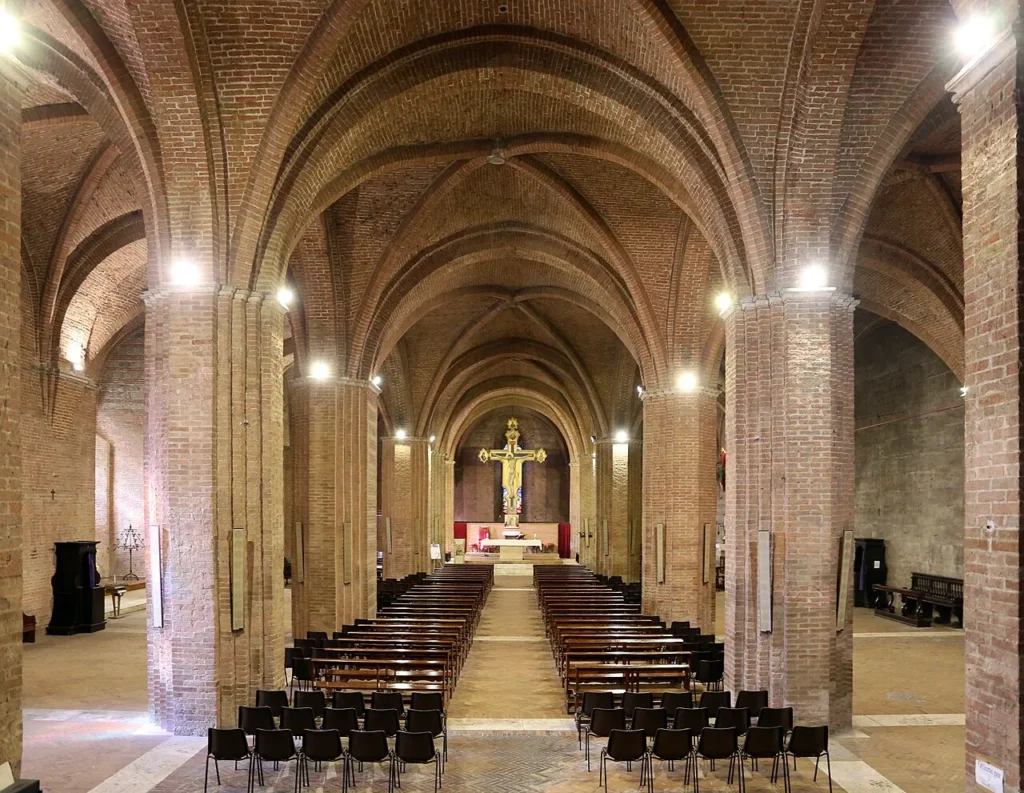
Sacristy
Accessible from the right transept or the right wall, the large sacristy (10) houses an altar adorned with the Madonna in Glory, also known as the Madonna of the Roses. This painting, dating back to 1526–1527, is attributed either to Sodoma or more likely to his pupil, Girolamo Magagni, known as Giomo del Sodoma. Opposite the altar, the grand painting Multiplication of the Loaves and Fishes by Ludovico Dondo, a Mantuan artist, was completed in 1635.
Above, the 17th-century paintings are reproductions of a pictorial cycle originally created for the choir chapel of San Lorenzo in Rome, with copies made by Giovanni Lanfranco and other Emilian artists.
Crypt
The complex also includes a Gothic crypt from the 14th century, accessible via a staircase at the end of the right nave or from the left side of the church. Constructed alongside the foundations of the basilica in the early 14th century, the crypt was later abandoned and repurposed for secular uses during the 16th century. It was eventually restored and reconsecrated in 1935.
Divided into three naves by sturdy pillars, the crypt features cross vaults and apses and serves as the primary space for religious functions during winter, as its climate is more temperate than the basilica above. The space includes notable artworks, such as the Crucifix by Sano di Pietro, positioned behind the main altar, and the Crucifixion, a signed and dated 1600 painting by Ventura Salimbeni.
Cloister
To the right of the façade, visitors can enter the cloister, originally built in 1425. The structure underwent restoration and partial reconstruction in 1941, preserving its historical and architectural significance.
Feast Day
Feast Day : Saint Catherine of Siena – 29th April
Saint Dominic – 8th August
The Basilica Cateriniana San Domenico in Siena, Italy, celebrates two major feast days: April 29, honoring Saint Catherine of Siena, with Mass, processions, and veneration of her relic, and August 8, dedicated to Saint Dominic, founder of the Dominican Order, featuring special liturgies and reflections on his mission. These events draw many pilgrims and worshippers to the basilica.
Church Mass Timing
Monday : 07:30 AM, 06:00 PM
Tuesday : 07:30 AM, 06:00 PM
Wednesday : 07:30 AM, 06:00 PM
Thursday : 07:30 AM, 06:00 PM
Friday : 07:30 AM, 06:00 PM
Saturday : 06:00 PM
Sunday : 07:30 AM, 09:00 AM, 10:30 AM, 06:00 PM
Church Opening Time:
Monday : 8:45 am – 6:00 pm
Tuesday : 8:45 am – 6:00 pm
Wednesday : 8:45 am – 6:00 pm
Thursday : 8:45 am – 6:00 pm
Friday : 8:45 am – 6:00 pm
Saturday : 8:45 am – 6:00 pm
Sunday : 8:45 am – 6:00 pm
Contact Info
Address :
Piazza S. Domenico, 1, 53100 Siena SI, Italy.
Phone : +390577286848
Accommodations
Connectivities
Airway
Florence Airport to Basilica of San Domenico, Siena, Italy distance between 1 hr 7 min (81.8 km) via Raccordo Autostradale Firenze – Siena.
Railway
Siena Station to basilica of san domenico siena italy distance between 8 min (2.9 km) via Via G. Mazzini.

